Home » Open Learning (Page 2)
Category Archives: Open Learning
Scary and Fascinating: Online Teaching in Challenging Times
Have you ever started writing on a topic and then something happens that changes everything? Well, that just happened to me. About a month prior to the COVID-19 pandemic, I was writing on the growing interest in and support for open and online learning in postsecondary education. Then poof! COVID-19 changed everything. Today I will share with you some of my initial thoughts on this topic and then reflect on how the events of the last month changed some of my thinking.
Here are some of my initial thoughts.

Following completion of the University of Windsor Office of Open Learning’s Certificate of Online and Open Learning and attendance at eCampusOntario’s Technology + Education Seminar + Showcase (TESS) conference, I initiated a study to explore the connection between the promising practices for teaching online linguistically and culturally diverse international students and student satisfaction and student perceptions of learning, which has recently received research ethics approval but is now paused. An overview of this study is available on my faculty web page. Also, working with two University of Windsor colleagues (Mark Lubrick and Carson Babich), I oversaw the writing of my first Open Educational Resource textbook (Leadership and Management in Learning Organizations), which we hope to publish in the next few months. All of this opened my eyes to the possibilities of online learning within the higher education sector.
And then, just before the pandemic broke, I enjoyed reading the Wiley Education Services study, “Student Perspectives of Online Programs: A Survey of Learners Supported by Wiley Education Services” (Magda & Smalec, 2020), in which student satisfaction with online learning was explored at 19 institutions where students were enrolled in Wiley-supported programs. The study provided some fascinating insights that showed ways to better meet student needs and expectations, including examine the complete student journey to remove barriers to flexibility, create a consistent learning experience to alleviate unneeded stress, and empower faculty to engage with students to improve the learning experience.
And here is a little of what we knew about online learning in North America before COVID-19.
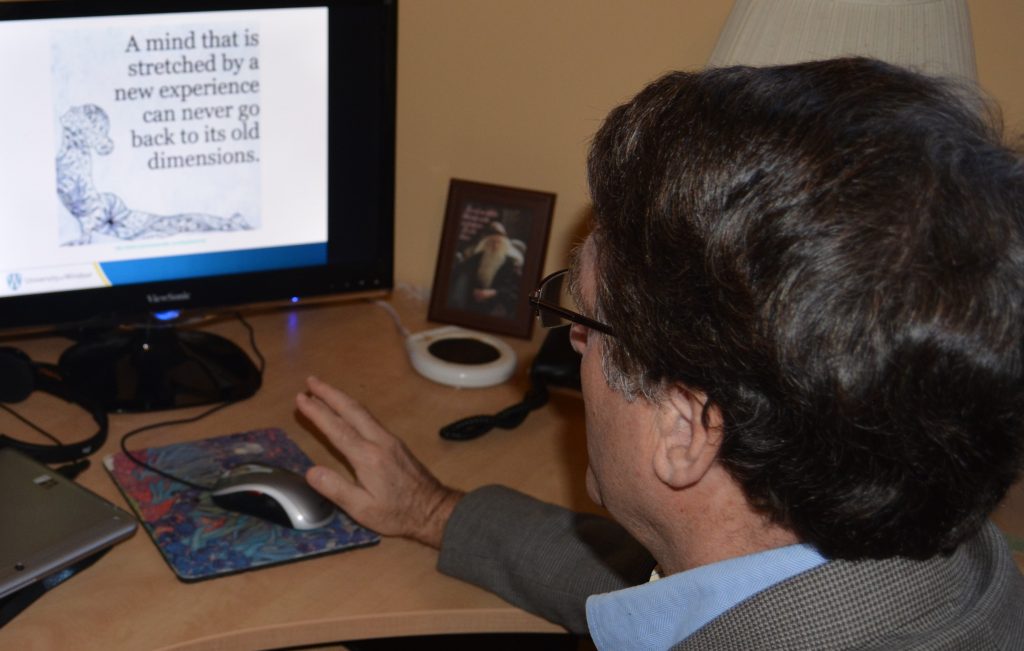
North American online education has seen a rise in popularity in recent years. The Canadian Digital Learning Research Association reported that Canadian postsecondary online course registrations grew by 10 percent in 2018 and 2019, and most institutions expect enrollments to increase in the coming year (Johnson, 2019). The U.S.-based National Center for Education Statistics (Ginder, Kelly-Reid, & Mann, 2017) reported that the number of students who take at least some of their courses online grew by 5.7 percent in 2017. More than 25 percent of students take at least one online course during their time at university of college (Cook, 2018). Undergraduate international students attending Canadian institutions are increasingly choosing to take online courses (Best Colleges, 2019; Thomson, & Esses, 2016).
And here is some of my thinking since COVID-19 joined our world.
Like most faculty, I found myself scrambling a bit to convert my in-person courses, some of which were hybrid courses, to fully online courses. With lots of support from our Office of Open Learning and Centre for Teaching and Learning, as well as experienced colleagues, I made the leap. It was a bit scary, but also fascinating.
On the scary side, there is me. While I had recently acquired professional development in open and online learning, I am an in-person educator who greatly enjoys the interaction with students. Seeing their smiles and their fears is a big part of how I ensure a learning-centred classroom environment. When this all moved to being digital, I, like many of my colleagues, was petrified. Then there are my students, who were equally scared since all of this happened within the last three weeks of the semester. Fortunately, our university put in place a flexible approach that included assessments and grades, which allayed many of their fears. But not all.
When I had my students online, I asked them about their experience. Here is what an international graduate student said:
While we miss the in-person connections with other students and our professors, going online was not really a problem. When I delivered a facilitated reading discussion, I found that I had more confidence due to my comfort with digital technology. I also found that there was more participation in class. Although in-person instruction is my preference, I found aspects of my online classes to be better than expected. In some cases, preferable to my in-person experience!
I also found the whole process fascinating. What we know is that our classes are filled with digital natives; that is, students who have always had technology in their lives. Taking ourselves, who might be described as digital immigrants, out of our comfort zone and letting students be our guides through this new digital world I found exciting and a little fun. It provided a flipped classroom of sorts where the students were doing some of the teaching, and we became the students. What could be more exciting?
Like many other postsecondary institutions, my university is offering its summer courses fully-online. There is also the likely possibility that fall classes similarly will be fully-online. Finishing off a term with online lectures is one thing. Moving to all courses, from beginning to end, being online is something all together different. The good news is we will all be doing it together.
Scary but fascinating!
-Clayton Smith
Best Colleges (2019). 2019 Online Education Trends Report. https://res.cloudinary.com/highereducation/image/upload/v1556050834/BestColleges.com/edutrends/2019-Online-Trends-in-Education-Report-BestColleges.pdf
Cook, J. (2018). Online education and the emotional experience of the teacher. New Directions for Teaching and Emotion. DOI: 10.1002/tl.20282
Ginder, S. A., Kelly-Reid, J. E., & Mann, F. B. (2017). Enrollment and employees in postsecondary institutions, fall 2016; and financial statistics and academic libraries, fiscal year 2016. Washington, DC: National Center for Education Statistics. https://nces.ed.gov/pubs2018/2018002.pdf
Johnson, N. (2019). Tracking online education in Canadian universities and colleges: National survey of online and digital learning 2019 national report. https://onlinelearningsurveycanada.ca/publications-2019/
Magda, S. J., & Smalec, J.S. (2020). Student perspectives on online programs: A survey of learners supported by Wiley Education Services. Louisville, KY: Wiley edu, LLC. https://edservices.wiley.com/student-perspectives-on-online-programs/
Thomson, C., & Esses, V. (2016). Helping the transition: mentorship to support international students in Canada. Journal of International Students, 6(4), 873-886. http://ojed.org/index.php/jis/article/view/323/247
Connecting Today’s Postsecondary Classroom to the Open Future
Postsecondary presidents and administrators are concerned about the rising cost of textbooks, with 85% of leaders supporting the use of OER’s (Lederman, 2019, March 13). Many education faculty members are increasingly looking to make use of OERs to customize their teaching resources to ensure that they are a good fit for the courses they are teaching. This is especially true for instructors engaged in teaching interdisciplinary courses in educational administration, policy, and leadership where there is no currently available open or online textbook.
At this year’s Canadian Society for the Study of Higher Education Conference, which will be held May 31-June 2, 2020 at Western University in London, Ontario, I will be joined by two of my University of Windsor colleagues (Mark Lubrick and Carson Babich) as cochairs for the panel, “Connecting Today’s Postsecondary Classroom to the Open Future: Open Education Resources (OER’s) Empower the Teaching of Educational Administration, Policy, and Leadership,” which will focus on the use of OER’s to teach interdisciplinary courses through the exploration of new pedagogical approaches.
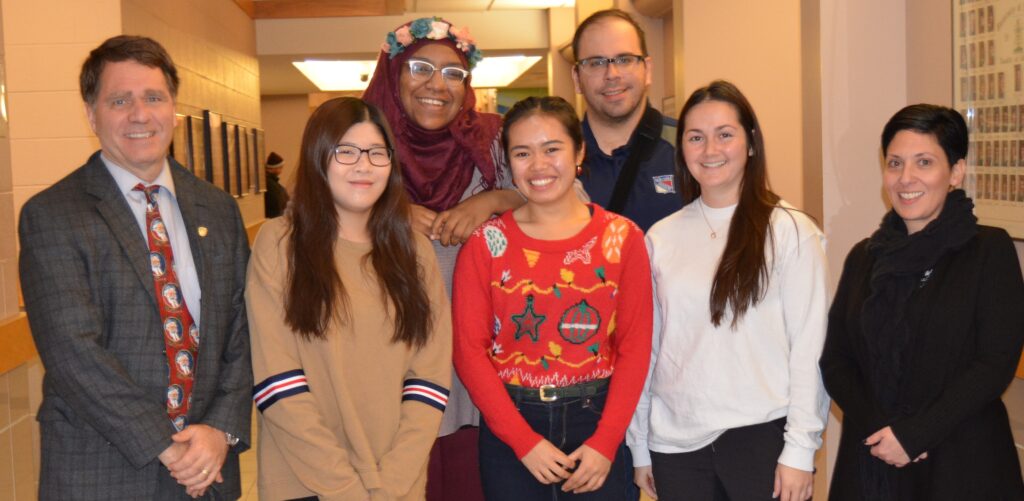
This panel will focus on two main research questions. How are postsecondary faculty making use of OER’s to teach interdisciplinary courses in educational administration, policy, and leadership with a particular focus on learning organizations? What specific factors should be considered when using OER’s to teach interdisciplinary courses?
Consider submitting a proposal. Some possible topics that you may want to consider could include: accessibility, class discussions, connection from one discipline to another, epistemology, equity, ethics evaluating/choosing a resource, experiential learning, flipped teaching, online collaborative teaching (OCT), pedagogical innovation, and research done around OER use in interdisciplinary courses
For more information contact me at Clayton.Smith@uwindsor.ca.
-Clayton Smith
Using Personas to Enhance Understanding of International Student Learning
At this week’s UWindsor GATAcademy, I had the pleasure of presenting a workshop on “Connecting Best Practices for Teaching Linguistically-Diverse International Students with International Student Satisfaction.” While we presented some of the findings from our recent research on this topic, we did it with a bit of a student spin, which made it fascinating to present.
First, let me acknowledge the work of two students. Miranda Pecoraro, an Outstanding Scholar and 3rd year Social Work student, and Renan Paulino, a MITACS intern from Brazil. They took our research and developed it into a game that permitted participants to engage in both constructivism and experiential learning as they learned about ways we can enhance the teaching and learning of international students. This was the first time we tried it, and from all reports, it went well.
I would also like to commend three other students who served on our expert panel for the game. These students included Victor Sam (Computer Science, Ghana), Sumeet Kaur (Bachelor of Arts-Criminology, India), and Ahuying Zhuo (Law, China). And, of course, our international student advisor, Deena Wang, who was instrumental in organizing the day.
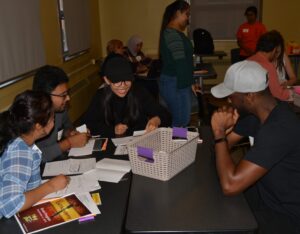
What we did was to build 5 personas representing international students at the University of Windsor and then provide the related teaching practices for each persona to a groups of participants. Each group was asked to select 10 practices (they were given an average of 20 to select from) they thought fit the assigned persona and then defend one of these to the wider group. The expert panel, using green (agree), red (disagree), and yellow (not sure) lollipop signs helped us understand how each teaching practice may or may not be appropriate for the persona. It was a wonderful display of constructivism and experiential learning.
In the end, the GAs and TAs came away from the workshop with a key point. As we approach our students, we need to learn enough about each student to determine what teaching practice will enhance learning, both inside and outside of the classroom. Factors such as country of origin, area of study, length of time studying abroad, and level of study all lead to better understanding of the learning preferences of international students.
This was fun!
-Clayton Smith

Mentors and Messes
While attending the American Association of Collegiate Registrars and Admissions Officers’ (AACRAO) Technology and Transfer Conference in Las Vegas this week, I dropped into a roundtable discussion called “Mentors and Messes” that was a follow-up to an earlier session in which Helen Garrett (University of Washington), Shweta Kadam (University of Nevada Las Vegas), and Christine Paal (Boston University) shared the top ten leadership lessons learned by women in technology.
Women technology professionals, many of them technology leaders on their own college and university campuses, attended this session. Others were relatively new to the profession. Each had a story to tell and share with their colleagues from across the country.
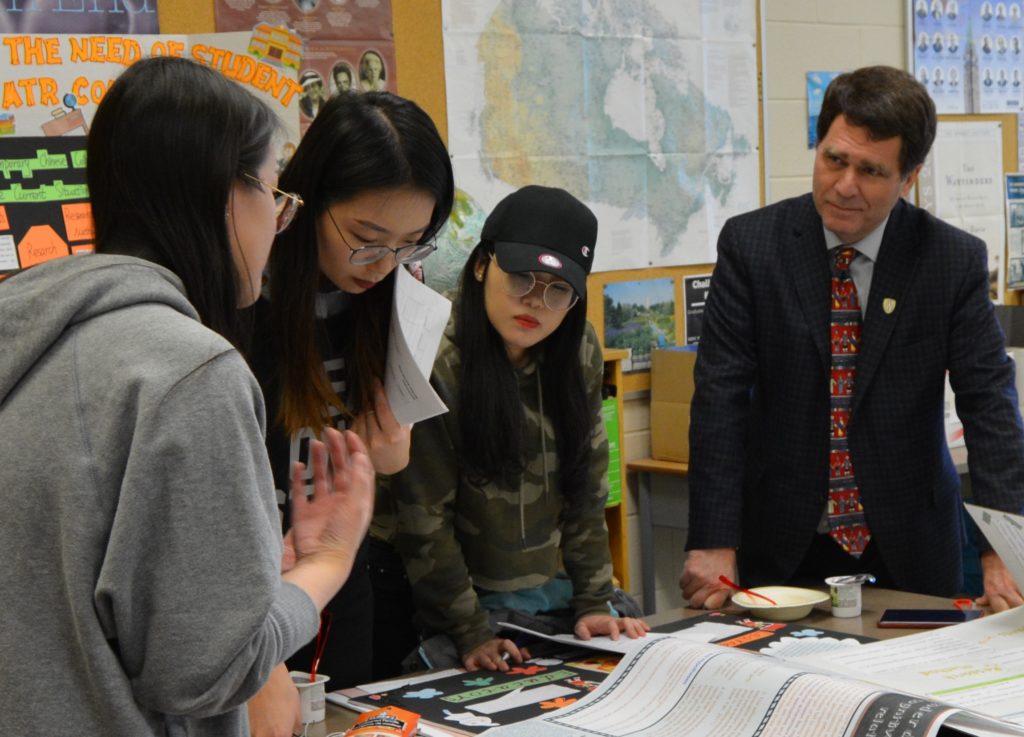
After decades of work in higher education trying to bridge gender equity, I was amazed by what I heard.
How can it be that we have made such little progress on this critically important issue?
We talk a lot about gender equity. Sometimes it is about salary. Sometimes it is about opportunity to advance in our field of choice. What I do not understand, however, is how we can still be facing some of the same challenges that confronted higher education a generation or two before us.
The theme of the discussion was mentorship. That we should each look to each other and to men who support gender equity to find ways of getting a fair salary, to receive a meritorious promotion, and to ensure that women’s voices are heard at all levels of the academy.
While I am an advocate for mentorship anywhere and everywhere, I guess I am thinking that we need to do more.
While attending this session, I reflected on a frustration I feel every day as a professor. In my classes, I work hard to make sure that all of my students are encouraged and supported so that they can achieve their potential whatever that might be. This goes for students from other cultures, those with disabilities, Indigenous learners, and all the other types of students that grace my classroom. This includes women who are preparing to become tomorrow’s faculty members and educational leaders at all types of learning organizations. I remain perplexed that they will face a world where gender equity may limit what they can achieve throughout their careers.
I further reflected with this impressive group of women technology leaders that I was blessed by a wonderful female mentor when I first began my career in higher education. Mary Elisabeth Randall was our associate vice-president for enrollment services who served as my boss when I was director of admissions at a small public university in Maine, the University of Maine at Augusta. As it turns out, she was also the sitting president of AACRAO. Mary Elisabeth encouraged me to become involved in AACRAO and to pursue my doctorate in higher education, both of which I did and that laid the foundation for my career journey. I will always remember her strength of character and her belief in me. It led me to think often about what women can and should achieve in our educational world.
So I encouraged those in attendance at this session to consider mentoring not only women, but also men. The power and example of mentoring can and does make a big difference in all of our lives.
I will continue to think about what else I can do to further gender equity in all parts of my life.
Clayton Smith
Ireland Take-Aways
While in Ireland last week, I became aware of the concept of “take-aways” rather than the North American term “to-go,” and so I thought I would reflect on a few take-aways from our recent, mostly sunny, trip to Ireland.
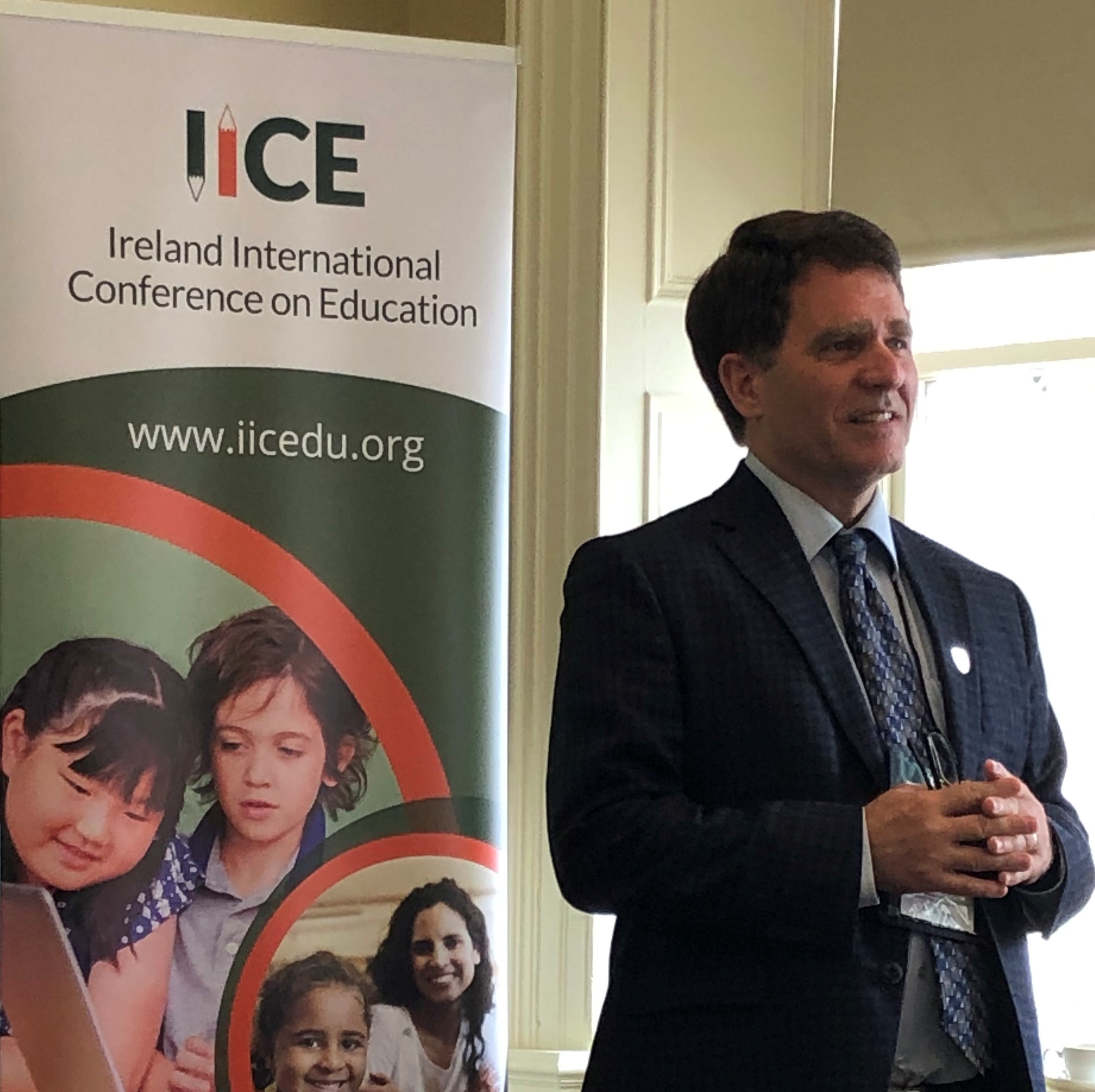
Let me start with my reason for visiting the emerald isle.
I had the pleasure of presenting a paper on some research my research team has recently completed on “Connecting Best Practices for Teaching Linguistically and Culturally-Diverse International Students with International Student Satisfaction and Student Perceptions of Learning” at the Ireland International Conference on Education, which was held in Dún Laoghaire, Ireland, a short distance from Dublin. It was well received and left me reflecting on how I might collaborate with researchers in other countries on this topic. So many are interested in learning more about how we might provide a student voice in our research on the practices for teaching international students.
This is a small conference (about 100 participants) that left me with a developing network of research colleagues from around the world–all with an interest in enhancing education within the post-secondary education sector. Here are a few highlights:
- Gabriel-Miro Muntean, from Dublin City University spoke about the EU Horizon 2020 NEWTON Project’s use of innovative technologies and enhanced learning methods and tools to create or inter-connect existing state-of-the-art teaching labs and to build a pan-European learning network platform to encourage more students to consider STEM careers. While only a few years in, it shows great potential for turning on a new generation or STEM scientists and practitioners.
- Michael Plummer, from MAPco Education Consultant Group, shared a bit about misguided public criticism of education, and special education in particular. Findings from his study revealed that there is a continuing lack of knowledge by the public on the issues around special education. He also said “You can teach about the profession, but you cannot teach someone how to be a teacher. Teaching is a complex art, and not everyone can do it.” Very powerful stuff. Really made me think about the individual characteristics that contribute to inspired teaching.
- Deborah Patterson and Susan Carlile, from Portland State University, intrigued us with a session called “Nags, Bitches and Beauties: Women in Leadership” in which they shared the challenges facing women leaders, and recommended development of formal and informal mentoring program, use of a network of support within and outside the organization, and increased training for allies. I have seen many of these challenges first hand, and was impressed with their body of research. Hopefully, it will lead to action in the academy to enhance the way we support women along the way to leadership roles.
- Adam Unwin, from University College London, spoke about some themes from his book with John Yandell, Rethinking Education: Whose Knowledge is it Anyway? In particular Unwin stressed the challenges associated with the impact of Neoliberal measurement approaches, which have done a lot to “deform the landscape of schooling” in the United Kingdom. It made me reflect on how we can address this approach as the Ontario Government pushes performance funding within the post-secondary sector in the next several years. He even gave me a copy of his book!
But you can’t just go to Ireland for work, so we also took in some of the sights.
We toured the Wicklow Mountains, otherwise known locally as the Dublin Mountains, which borders the counties of Dublin, Wexford, and Carlow. Of course, they really are not mountains. Our tour guide told us at 561 meters, they are not tall enough to be mountains. But are they ever beautiful and mountain-like!
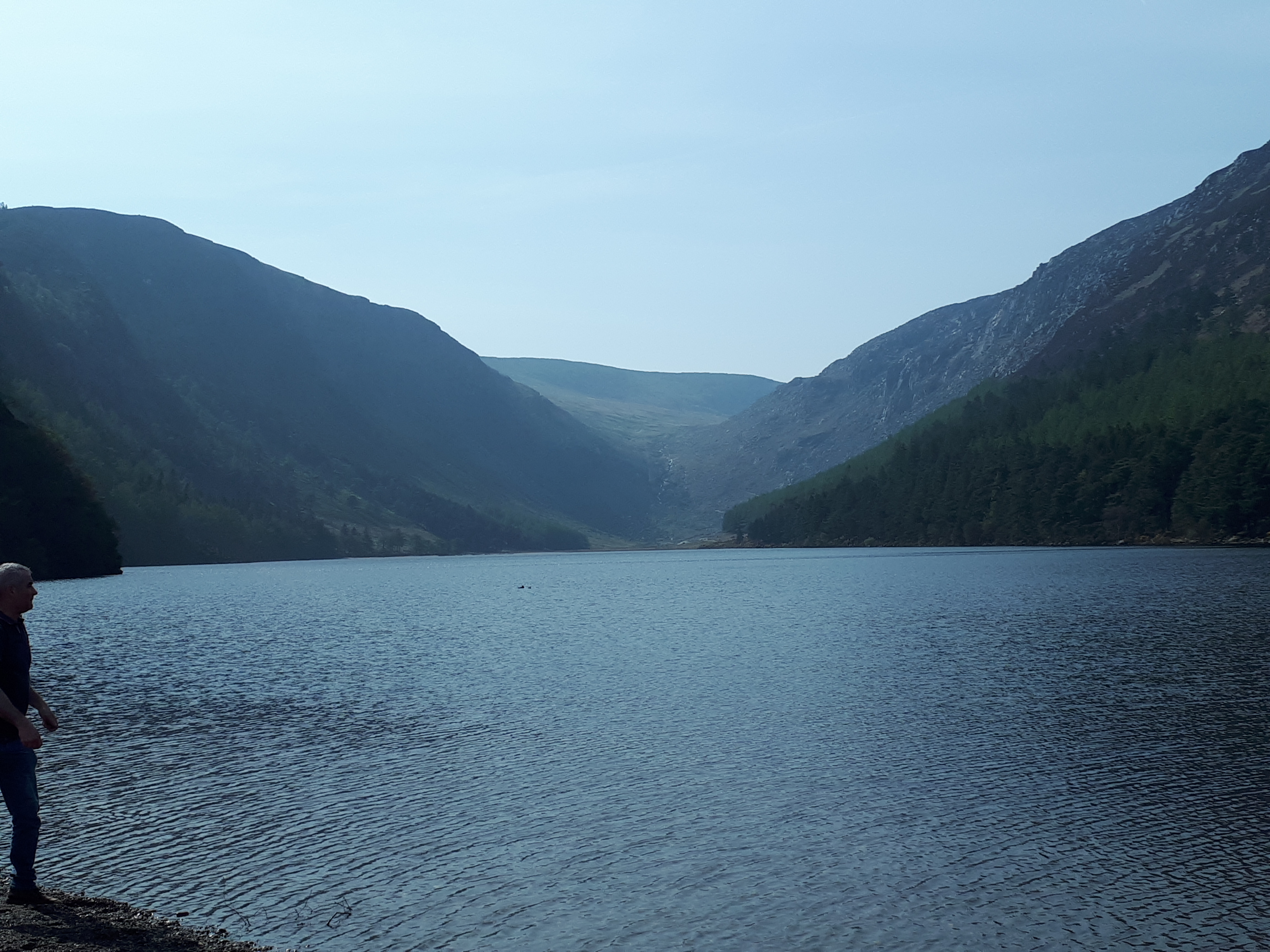
We also visited the western part of the country and took in side trips to Cliffs of Moher and the City of Galway. The Cliffs of Moher are really impressive. They stretch eight kilometers, reaching a height of 214 meters, with a vista embracing the Aran Islands. Almost thought I was in Newfoundland. The warm–we were told they are not always warm–winds whipping across the landscape took us back to the Harry Potter films, one of which was filmed here.

Galway is wonderful. Full of cultural charm, with lots of shopping and, of course, more restaurants and pubs than one can count.
Then there is Dublin itself. So much history with the experience of nationhood so near the surface of many conversations. Some of what tops the list include Dublin Castle, St. Patrick’s Cathedral, Christ Church, the National Museum of Ireland, St. Stephen’s Green, Trinity College, and the huge Phoenix Park that includes the Dublin Zoo, home to some very famous lions.
Our tour guides (two of the three were named John) used a wonderful style of speaking that I think I will try to use more in my teaching. Basically, they introduced what we would do, then told a story or two about what we would see, and then summarized before moving on to a new slice of the tour. Then, at the end, they shared some of the highlights. While it may be something that is just present in the Irish approach to interpersonal communications, it really worked, and was enjoyed by everyone.
Perhaps our true take-aways centre on the people, including the colleagues we met at the conference along with the native Irish we came to embrace through our travels in this breath-taking land.
I think we will be coming back.
Clayton Smith
Using Mentimeter to Discuss Current Educational Issues
In my Teaching and Learning, Part 1 class (EDUC119B), I recently used Mentimeter (www.menti.com) in a large class (110 students), which meets in our large lecture hall in the Education Building. This class is recorded for students unable to make class.
Students created a class-wide word cloud in response to the question, “what are the current educational issues facing teachers today? This was done as a follow-up to a guest lecture presented by Dr. Lyndsey Jaber, a school psychologist with the Greater Essex County District School Board, on the topic “Bullying: Definition and Implications.”
They then held two group discussions that included: a) identify the top 5 issues facing teachers today and indicate your reason for selected these iss
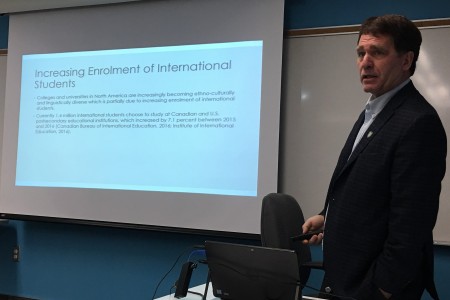
ues, and b) select one of your issues and discuss how you would handle this issue during your classroom observation. A short Blackboard quiz was used to assess student learning.
Here is a link to the word cloud students created, which I subsequently posted to our Blackboard course page.
After being empowered by Dr. Jaber’s presentation, students were able to bring it into their area of interests by way of the creation of the Mentimeter word cloud and the subsequent discussions we had during the second part of class. What made this work particularly well was the speed by which the cloud developed and the observation that others in the class picked some of the same issues, which led to the group discussions that followed. So rather than lecturing about the educational issues facing teachers, the class was able to discover these issues and then share their thoughts about the top vote getters. Very powerful and impactful!
Probably the only issues we faced were that not everyone had a phone or laptop so some students partnered up, and the focus of the group discussions were probably impacted by the extroverts in the group, and may have resulted in some students not weighing in on their top issues of concern.
In reflection, when I do this again I am thinking about asking students to write a one minute essay on an issue they believe strongly about, which they can upload to Blackboard during class. That way I can be sure to give voice to all students on this important topic.
Clayton Smith
Taking the Plunge
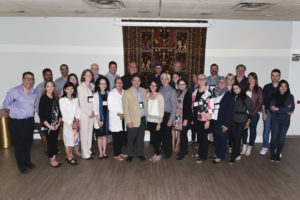
After more than 30 years engaged in higher education administration in the U.S. and Canada, I took the plunge and returned to my teaching roots. And what an adventure it has been!
I took nearly everything that our Centre for Teaching and Learning offered as a way of rebooting and modernizing my approach to teaching. This took me through the Certificate in University Teaching, Blackboard Boot Camp, the Teaching Dossier Academy, and lots more. I learned about SoTL and scholarly teaching. It resulted in me adopting “teaching for learning” as my teaching style, which, of course, was a perfect match to my dean of students’ experiences putting students first in all we do.
More recently, I have explored the open practice world with the help of our Office of Open Learning. It has left me inspired to move away from traditional pedagogies and adopt a more open path to teaching and learning. This led me to explore educational technologies, curation, collaboration, experimentation, and scholarship related to open practice. I am even currently considering the development of an Open Educational Resource for one of my courses and have now created an ePortfolio!
The combination of “teaching for learning” and entering the open learning world has led me to want to learn more about how we as educators, teachers, researchers, and supporters of student learning can more fully centre our work on enhancing student learning.
Where this adventure will lead me, I do not know. What I hope is that it will make me a better teacher, facilitator, mentor, and coach for my students.
I cannot wait to experience what is next on my journey.
From time to time, I will write in this blog about my experiences. Maybe you will tune in and reflect with me about how you incorporate “teaching for learning” and open learning pedagogies in your teaching.
Join me!
Clayton Smith
Recent Comments